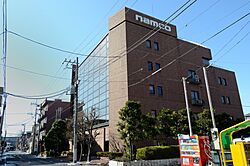Namco facts for kids
Logo (reused by Bandai Namco Amusements for its arcade chain of the same name)
|
|

Headquarters in Ōta, Tokyo
|
|
|
Native name
|
株式会社ナムコ
|
|---|---|
|
Romanized name
|
Kabushiki-gaisha Namuko |
|
Formerly
|
|
| Subsidiary | |
| Industry | Video games |
| Fate | Merged with Bandai's video game operations to form Namco Bandai Games |
| Successor | Bandai Namco Entertainment |
| Founded | June 1, 1955 |
| Founder | Masaya Nakamura |
| Defunct | March 31, 2006 |
| Headquarters |
,
Japan
|
|
Area served
|
Worldwide |
|
Key people
|
|
| Products | Video games |
| Parent | Namco Bandai Holdings (2005–2006) |
| Divisions |
|
| Subsidiaries |
|
Namco Limited was a Japanese multinational video game and entertainment company founded in 1955 which operated video arcades and amusement parks globally, produced video games, films, toys, and arcade cabinets. They were one of the most influential figures in the worldwide coin-op and arcade game industry; Namco produced several multi-million-selling game franchises, such as Pac-Man, Galaxian, Tekken, Tales, Ridge Racer, and Ace Combat. In 2006, Namco merged with Bandai to form what is now named Bandai Namco Holdings; the standalone Namco brand continues to be used for video arcade and other entertainment products by the group's Bandai Namco Amusements division.
The Namco name comes from Nakamura Manufacturing Company, derived from its founder Masaya Nakamura. In the 1960s, it manufactured electro-mechanical arcade games such as the 1965 hit Periscope. It entered the video game industry after acquiring the struggling Japanese division of Atari in 1974, distributing games such as Breakout in Japan. The company renamed itself Namco in 1977 and published Gee Bee, its first original video game, a year later. Among Namco's first major hits was the fixed shooter Galaxian in 1979. It was followed by Pac-Man in 1980. Namco prospered during the golden age of arcade video games in the early 1980s, releasing popular titles such as Galaga, Xevious, and Pole Position.
Namco entered the home market in 1984 with conversions of its arcade games for the MSX and the Nintendo Family Computer, later expanding to competing platforms, such as the Sega Genesis, TurboGrafx-16, and PlayStation. Namco continued to produce hit games in the 1990s, including Ridge Racer, Tekken, and Taiko no Tatsujin, but later endured financial difficulties due to the struggling Japanese economy and diminishing arcade market. This led to the 2005 announcement of a merge with toy maker Bandai, which was completed in 2006 as Namco Bandai Holdings; Namco's former video games division was merged into a subsidiary of the holdings company, Namco Bandai Games, now called Bandai Namco Entertainment. Namco is remembered in retrospect for its unique corporate model, its importance to the industry, and its advancements in technology.
Legacy
Namco was one of the world's largest producers of video arcade games, having published over 300 titles since 1978. Many of its games are considered some of the greatest of all time, including Pac-Man, Galaga, Xevious, Ridge Racer, Tekken 3, and Katamari Damacy.
Pac-Man is considered one of the most important video games ever made, having helped encourage originality and creative thinking within the industry. Namco was recognized for the game's worldwide success in 2005 by Guinness World Records; by that timeframe, Pac-Man sold over 300,000 arcade units and grossed over $1 billion in quarters globally. In an obituary for Masaya Nakamura in 2017, Nintendo Life's Damien McFerran wrote: "without Namco and Pac-Man, the video game arena would be very different today."
Namco's corporate philosophy and innovation have received recognition from publications. In a 1994 retrospective on the company, a writer for Edge described Namco as being "among the true pioneers of the coin-op business", a developer with a catalog of well-received and historically significant titles. The writer believed that Namco's success lay in its forward-thinking and firmness on quality, which they argued made it stand out from other developers. A staff member of Edge's sister publication, Next Generation, wrote in 1998: "In a world where today's stars almost always become tomorrow's has-beens, Namco has produced consistently excellent games throughout most of its history." The writer credited the company's connections with its players and its influential releases, namely Pac-Man, Xevious, and Winning Run, as the keys to its success in a rapidly changing industry.
Publications and industry journalists have identified Namco's importance to the industry. Hirokazu Hamamura, chief editor of Famitsu, credited the company's quality releases to the rise in popularity of video game consoles, and, in turn, the entirety of Japan's video game industry. Writers for Ultimate Future Games and Official UK PlayStation Magazine have credited the company and its games to the early success of the PlayStation, one of the most iconic entertainment brands worldwide. In addition, Official UK PlayStation Magazine wrote that Namco serves as "the godfather of game developers", and one of the most important video game developers in history.
Staff for IGN in 1997 claimed that Namco represents the industry as a whole, with titles like Pac-Man and Galaga being associated with and representing video games. They wrote: "Tracing the history of Namco is like tracing the history of the industry itself. From its humble beginnings on the roof of a Yokohama department store, to the impending release of Tekken 3 for the PlayStation, Namco has always stayed ahead of the pack." In 2012, IGN listed Namco among the greatest video game companies of all time, writing that many of its games—including Galaga, Pac-Man, Dig Dug, and Ridge Racer—were of consistent quality and helped define the industry as a whole.
See also
 In Spanish: Namco para niños
In Spanish: Namco para niños

